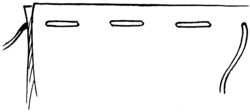In
sewing,
to
tack
or
baste
is to make
quick, temporary
stitching
intended
to be removed.
Tacking
is used
in a variety
of ways:
- To temporarily hold a seam or trim in place until it can be permanently sewn, usually with a long running stitch made by hand or machine called a tacking stitch or basting stitch.
- To temporarily attach a lace collar, ruffles, or other trim to clothing so that the attached article may be removed easily for cleaning or to be worn with a different garment. For this purpose, tacking stitches are sewn by hand in such a way that they are almost invisible from the outside of the garment.
- To transfer pattern markings to fabric, or to otherwise mark the point where two pieces of fabric are to be joined. A special loose looped stitch used for this purpose is called a tack or tailor's tack.
- A basting stitch is essentially a straight stitch, sewn with long stitches and unfinished ends. The basting stitch is used for temporarily holding sandwiched pieces of fabric in place. The stitch is removed after the piece is finished. Often used in quilting or embroidery.
External references

Learn more about sewing.
| The above article is licensed under the GNU Free Documentation License. From Wikipedia, the free encyclopedia (https://en.wikipedia.org/wiki/tack_(sewing)). 7/4/09 Above article modified by Apparel Search |